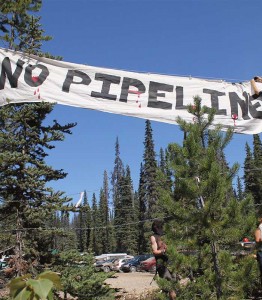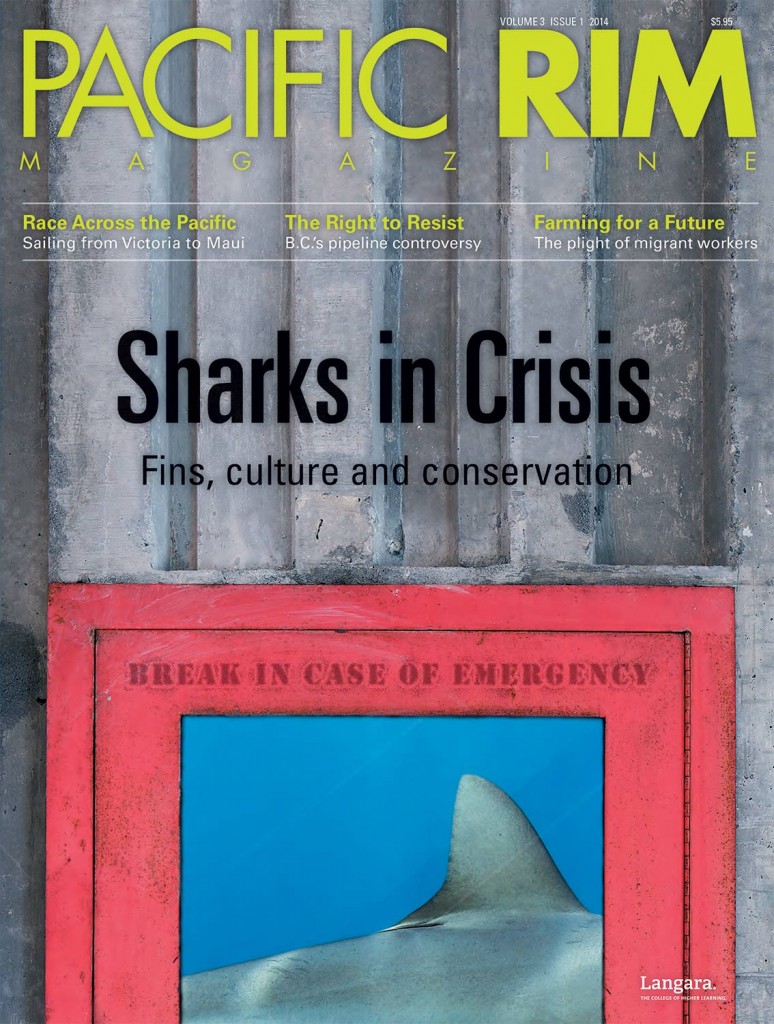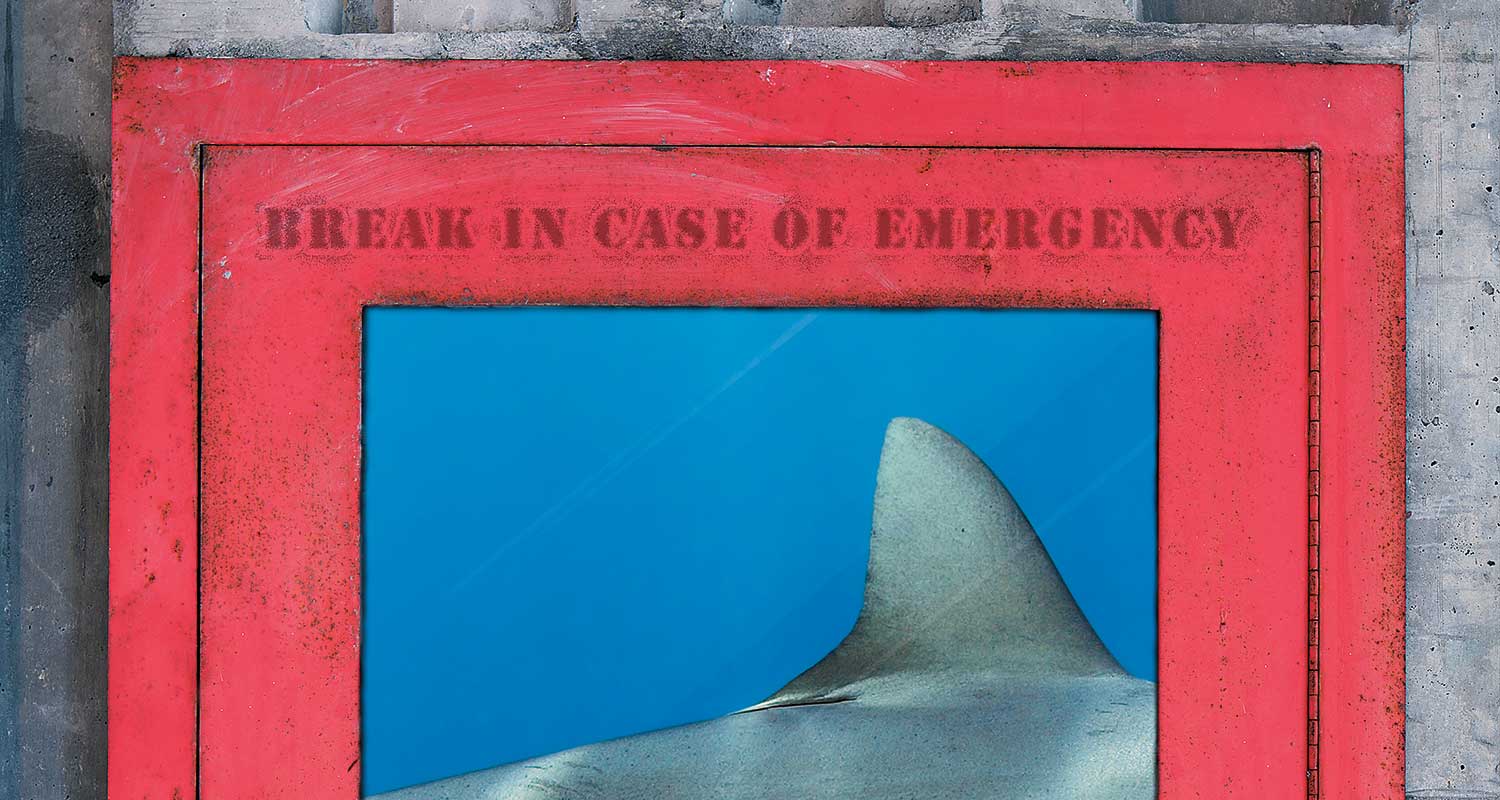The clear, turquoise water of the Widzin Kwa (Morice River) rushes downstream. Nearby, in the dense, green forest of B.C.’s northwestern Central Interior is the skeleton of an earthen pithouse. The structure’s long, arching beams join in a circle to form a roof that will keep the rain out. This will be home to a family of the Unist’ot’en (C’ihlts’ehkhyu or Big Frog), a clan of the Wet’suwet’en Nation, whose ancestors lived on this same land. Members of the Unist’ot’en are working together to build cabins, permaculture gardens and pithouses to protect their land and way of life from the threat posed by seven proposed pipeline projects that would cross their territory.
Composed of 13 houses within five larger clans, the Wet’suwet’en Nation has lived in the Central Interior of B.C. for millennia. Within their territories are six Wet’suwet’en communities. Toghestiy, a hereditary chief of the Likhts’amisyu (Fireweed) Clan says, “We have a history that goes way back in time; we have relatives all along the Pacific Northwest Coast, from California to Alaska.”
Many people in B.C. have heard of the controversial Enbridge Northern Gateway Project (ENGP), which would pump diluted bitumen from the Alberta tar sands to Kitimat, B.C., where it would then be shipped to refineries in emerging markets in Asia. The ENGP would also cross the territories of approximately 50 Indigenous Nations (including the Wet’suwet’en) and approximately 1,000 rivers and streams, (including the Fraser River watershed). Recently endorsed by the National Energy Board (a federal regulating body), the ENGP now awaits the government of Canada’s final stamp of approval from the federal cabinet.
[Editor’s note: since the original publication of this story, the ENGP has been approved by the federal cabinet. Click here to see the Unist’ot’en clan’s statement following the federal approval.]
“We don’t recognize [government agencies] because they continue to attempt to hand out permits and licences to companies that want to come and do extraction on our land without asking us permission,” says Toghestiy. The Gitxsan and Wet’suwet’en Nations won a landmark victory thirteen years after filing a lawsuit in 1984. The Supreme Court’s findings in the Delgamuukw/Gisday Wa case (reflecting the names of a Gitxsan and a Wet’suwet’en hereditary chief) ruled that aboriginal title is a right to the land itself, and that the use of Indigenous land must not impair its traditional use by future generations. This marked the first time that a Canadian court had directly addressed the definition of aboriginal title. “Just because the federal and provincial governments make statements about approving development on our unceded and unsurrendered lands does not mean that this is going to be the last and final word,” says Toghestiy. “There is no ‘bill of sale’ stating that we have forfeited our lands to anyone. We still occupy and enjoy the lands left to us by our ancestors.”
B.C.’s Energy Landscape

In total, there are seven proposed pipeline projects that would pass through Unist’ot’en land. These projects, however, represent only a piece in a much larger fossil fuel-puzzle, and in the B.C. government’s plan to turn central B.C. into a global energy corridor.
“People are talking about Enbridge as if it’s the only pipeline that’s proposed,” says Maryam Adrangi, former climate and energy campaigner for the Council of Canadians (a non-profit organization which campaigns for social action), “and I think it’s distracting from the fact that the [federal] government actually [has] this giant energy strategy that includes way more than Enbridge. And the same with the B.C. government. I think they are almost taking advantage of that in silently pushing through all these other projects, including the Pacific Trails Pipeline.”
In an email to subscribers, the Oil and Gas Investment Bulletin referred to the provincial Liberals’ recent re-election as “the single most important election to the energy landscape in all of North America in several years.” In addition to oil and gas pipelines, the B.C. government’s plans include coal and metal mining, building liquefied natural gas plants, expanding hydraulic fracturing projects (more than 11,000 wells have been drilled since 2000) and constructing dams to power these operations.
Industry projections estimate that the ENGP would add cad 270 billion to the GDP over 30 years and would create 1,150 long-term jobs. The industry also asserts claims of benefits to First Nations, which have been disputed by many Aboriginal Groups, including the option to buy a 10 percent stake in the project. It remains unclear whether, in the event of an oil spill, this stake would limit Enbridge’s responsibility to clean up.
Although Enbridge claims to have the support of 26 “Aboriginal equity partners,” this number has been denounced by Art Steritt, executive director of The Coastal First Nations. He asserts that the majority of bands in B.C. are adamantly opposed. Only two First Nations have publicly signed on, and the agreements in question are now being challenged by members of those communities.
The Resistance
Over 130 First Nations have endorsed the “Save the Fraser Declaration,” an Indigenous law banning tar sands pipelines and tankers from crossing B.C. Approximately 50 of those Nations would be directly affected by the ENGP corridor.
The trip to Unist’ot’en territory reveals just what is at stake. “You’re basically crossing this beautiful, gorgeous, quickly flowing river and the water is so crystal clear, and you’re entering these pine forests,” says Adrangi. The Unist’ot’en fish, trap and collect clean drinking water from the nearby Widzin Kwa.
“These pipelines impact us and our way of life profoundly, because we would rather be simply living our cultural values and principles on the lands, and teaching our future leaders the virtues of being a strong and proud traditionalist,” says Toghestiy.
The Morice River Bridge crosses the Widzin Kwa from territory managed by the Gidimt’enyu (Bear) Clan to the Unist’ot’en territory of Tal Bits Kwa. This bottleneck entrance to the protected territory has recently become the site for the revival of an age-old tradition: observing the Free, Prior and Informed Consent Protocol. When visitors arrive at the bridge, members of the Unist’ot’en clan ask them a series of questions to determine their intentions. If someone is perceived as potentially harmful to the land or the people, the Unist’ot’en present them with a single eagle feather. In traditional Wet’suwet’en law, this is the only and final notice of trespass. Many surveyors working for oil and gas companies have been given this eagle feather.
“There is no ‘bill of sale’ stating that we have forfeited our lands to anyone. We still occupy and enjoy the lands left to us by our ancestors.”
Others, however, are granted permission to visit Tal Bits Kwa, including people who come each summer to attend the Unist’ot’en Action Camp. The Unist’ot’en host this multi-generational gathering, which brings people together to discuss decolonization, to strategize against the pipelines, and to get to know each other in the process. Through a variety of workshops, campers explore issues of displacement and lack of consultation with First Nations.
Heather-Emil Olson of Rising Tide Vancouver Coast Salish Territories, a grassroots environmental justice group, attended the camp this summer. “It is a pretty emotionally powerful thing to [be on] the land that has all these proposed pipelines, and to be there for this action camp that’s being organized by the people that are on the front lines defending their territories from these projects,” says Olson.
The camp has grown from an annual event into the permanent blockade it is today. In 2012, after the Unist’ot’en built a cabin directly on the proposed path of the ENGP and the Pacific Trails Pipeline, both projects were rerouted. The community is now building homes and digging gardens on the amended route. “I am moving into [a] pithouse this summer full time,” says Toghestiy, “to live a life that my ancestors would be proud of.”
Gathering Voices
The Athabasca Chipewyan First Nation, directly downstream from Fort McMurray’s tar sands, recently filed lawsuit against the federal government and Shell Canada regarding Shell’s Jackpine Mine Expansion project proposal. The Squamish and Tsleil-Waututh Nations co-signed a declaration to protect the Salish Sea (the Pacific Ocean), and to collaborate to oppose expansion of the Kinder Morgan’s Trans Mountain Pipeline Expansion Project, which would more than double pipeline capacity and potentially cause one supertanker a day to enter the shallow waters of the Burrard Inlet. Along its route, the Keystone XL Pipeline Project (which would bring diluted bitumen from Hardisty, Alberta, to refineries in Steele City, Nebraska) has also been met with resistance from seven tribes of the Lakota Nation, as well as by tribal members in Idaho, Oklahoma, Montana, Nebraska and Oregon.
Throughout 2013, members of all five Wet’suwet’en clans stood up at seasonal feasts to express their solidarity against all pipelines. “We just had a community meeting recently,” says Toghestiy, “[and] the majority of the people that stood up and spoke were very adamant that there will be no pipelines coming through our lands, and they’re willing to do what it takes at any cost to shut down [the pipeline projects].”
“This is what we’ve had to deal with for a long time,” says Badger Jack, a member of the Nxwisten Clan of the St’át’imc Nation and attendee of the Unist’ot’en Action Camp. “We’ve been affected greatly by colonization; we went from 60 million to 800 thousand.” Solemn but with a mischievous glint in his eyes, Jack says, “There’s a lot of work that needs to be done. Good thing I’m still young.”
[Editor’s note: the map illustration that originally accompanied this article in print contained inaccuracies. Please visit the following websites for more information regarding the geography of the area and proposed locations of pipeline projects: http://unistotencamp.com/?page_id=26, http://www.wetsuweten.com/territory]











